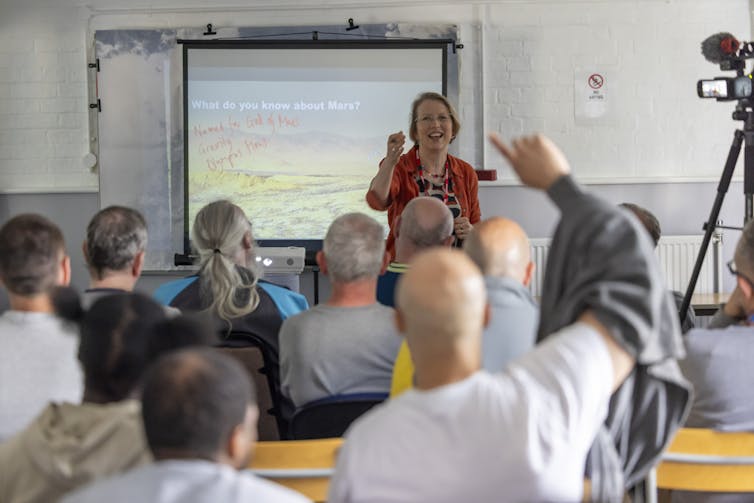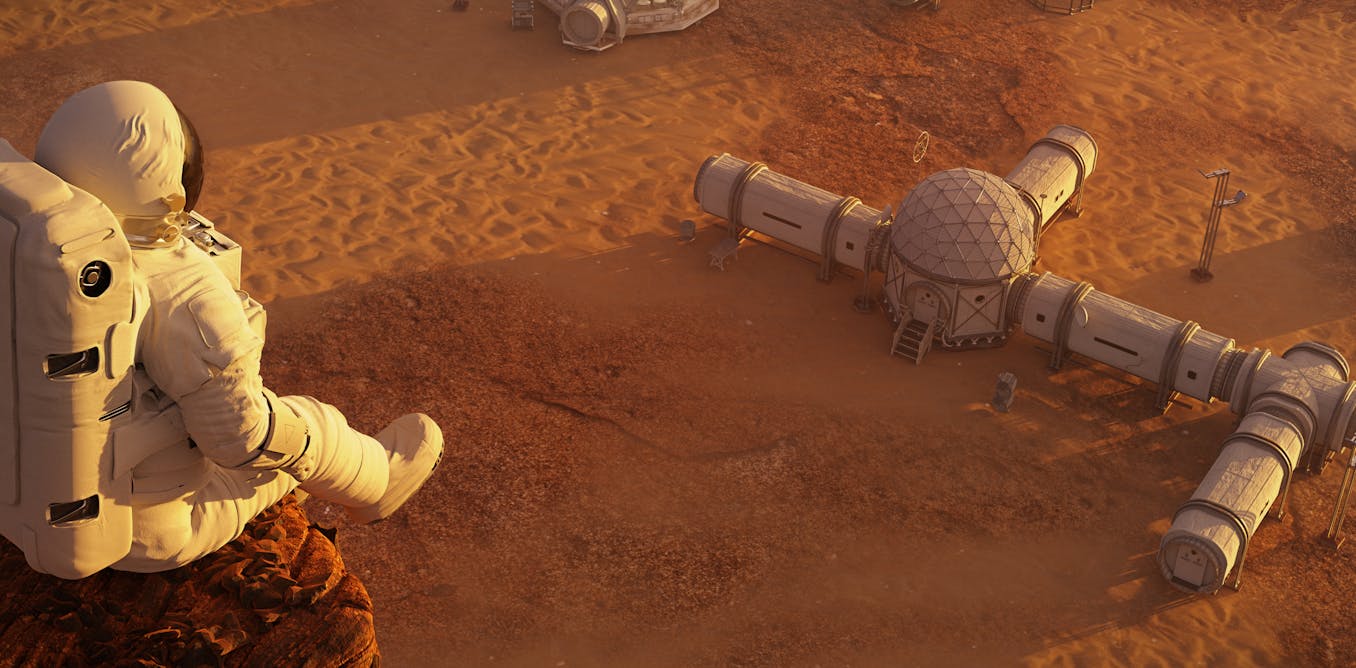I have been researching the possibility of living on Mars for several years. But it took an invitation to give a talk about space at HMP Erlestoke in England – a category C men’s prison – to make me realise that there are a surprising number of similarities between the challenges that would be faced by would-be Martians and daily life in jail.
The talk was part of a literary festival called “Penned Up”. As I discussed the parallels between Mars and prison with those incarcerated at HMP Erlestoke, the men agreed with me that, despite seeming so different, they both would share long-term isolation, confinement and psychological challenges (not to mention bad food).
So, as plans for exploration of Mars advance and we consider how to survive on this distant and hostile world, could there be important lessons from an environment closer to home – the modern prison? Understanding this overlap could be critical for ensuring the wellbeing of those we send to Mars. We know the terrible conditions of prisons can have a severe impact on people, and perhaps we can learn from that to help keep others safe and well.
It’s important to recognise the fundamental distinction between prisons and space exploration. Prisons are a punitive measure, depriving individuals of their freedom, while space exploration is a highly selective, paid endeavour undertaken by choice. As I saw, living in prison is a profoundly challenging environment. Despite legal minimum standards, overcrowding and shortages mean many prisons fail to uphold them.
Get your news from actual experts, straight to your inbox. Sign up to our daily newsletter to receive all The Conversation UK’s latest coverage of news and research, from politics and business to the arts and sciences.
The profoundly negative impact of poor prison conditions highlights the urgent need for effective solutions. But the knowledge gained from this could also then help support people in other challenging and remote environments, such as space exploration.
We have many years’ experience of studying psychological and team challenges from isolated, confined and extreme environments such as submarines, polar research stations, space simulators on Earth and space stations. But few people have looked to the public prisons on our doorstep for what we can learn.
Extreme routine
Daily life in both a prison and in space is governed by structured routines. In prisons, days are often planned down to the minute, dictating everything from waking to sleeping. This rigid scheduling is mirrored by mission-controlled timetables for astronauts.
Mandatory work is another common thread. Prison routines often include assigned tasks, such as kitchen or laundry duty, which serve the needs of the facility. Similarly, Martian astronauts would need to perform scientific experiments, equipment maintenance and resource production duties. Mandatory work can sometimes lead to resentment if there’s little autonomy.
Basic food and limited sleep is another common factor. When I asked the inmates what the food was like, they laughed. A staff member explained that the budget is £3.08 per person (the government benchmark figure is even less at £2.70 per person per day). Prison food can be of low nutritional value and meal times are fixed, impacting both health and morale.

Photo by Andy Aitchison., CC BY-SA
On Mars, astronauts would consume carefully planned dehydrated meals, which would no doubt have a higher budget and be nutritionally richer, but it is not as good as freshly cooked food back on Earth.
Sleep, a fundamental need, can also be elusive in both environments. In prisons, it can be disrupted by noise and poor conditions. Astronauts aboard the International Space Station are continuously exposed to an average noise level of 72 decibels, which is equivalent to the sound of motorway traffic from a distance of 15 metres.
Limited space
Prison cells are famously small, often measuring little more than a few square metres, and frequently housing several people. They offer minimal personal space and little privacy. The European standard – if it’s upheld – is a minimum of four square metres per person in a single cell.
Similarly, Martian habitats, designed to function with the minimum resources and with a focus on life support, will also be challenging space-wise.
For example, the Apollo Command and Service module which went to lunar orbit had a volume of just 6.2 cubic metres for three astronauts. This lack of personal space and privacy in both settings can lead to heightened stress levels and challenges to emotion regulation.
Both places also provide a potentially high-risk environment. The threats may be different – often interpersonal in prisons – from violence, sexual assault, and extortion to potential staff abuse-, mainly environmental – radiation, cold and lack of air on Mars. But they can lead to a persistent state of vigilance which can significantly impact mental well-being in both cases.
Dealing with isolation
Perhaps the biggest parallels lie in the psychological challenges arising from prolonged isolation. Imprisonment involves a significant separation from family, friends, and the outside world, leading to feelings of isolation and loneliness.
While astronauts on a mission to Mars are highly trained professionals and have chosen to go, they too will operate under a significant degree of control. With a likely round trip time of two years, astronauts embarking on a mission to Mars may also experience isolation. This could lead to feelings of disconnection and homesickness, as has been studied in volunteers on Earth.
Prisoners experience a near-complete lack of control over even the most basic aspects of their daily existence. You can see the importance of feelings of control in the fact that even astronauts and cosmonauts sometimes rail against or even disobey mission control’s strict guidelines, as the Nasa astronaut Clayton Anderson has written about in his candid book The Ordinary Spaceman.
Social dynamics
Both groups require living in close quarters with a limited, unchanging set of companions. In prison, people are confined to a relatively small social environment, which can lead to complex subcultures and the potential for interpersonal conflict and violence, though supportive relationships can also be a crucial resource.
Equally, for Martian crews, strong group cohesion and mutual support will be absolutely essential. However, the inherent stress of the mission, confined living conditions and significant communication delays with Earth could still lead to tensions.
So we see that lessons learned from studying the experiences of people in jails can provide valuable insights for mitigating the negative impacts of life on Mars.
Strategies such as designing habitats to maximise personal space and privacy, improving food and maximising autonomy will be needed for Martian travel. It will be important to provide access to meaningful activities to combat monotony, ensuring access to comprehensive mental health support and fostering strong social connections and support networks. These have all been studied in prisons.
By trying to improve prison conditions and continuing to learn from prisons, we can better prepare our pioneers for the unprecedented challenges of making a home on Mars, improving their chances of survival and their ability to thrive.
![]()
Lucy Berthoud receives funding from UK Space Agency and UKRI.



